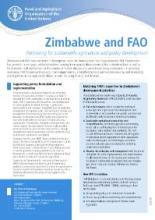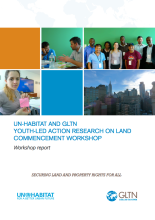/ library resources
Showing items 1 through 9 of 12.Zimbabwe and FAO have partnered in development since the country joined the Organization in 1981. Cooperation
has grown in recent years, with interventions ranging from capacity development at the institutional level as well asThe land challenge is central to the broader youth dynamics of migration, employment, livelihoods and belonging. The more than 1.8 billion youth living worldwide represent not only a land challenge, but an untapped potential in moving the tenure security agenda forward.
This report identifies FAO’s activities concerning access to natural resources (ANR), and identifies other organizations that use explicitly or implicitly a sustainable livelihoods approach in relation to ANR.
On the occasion of the International Year of Mountains-2002, FAO and its partners undertook a large-scale assessment and global review of the current status and future trends of integrated and participatory watershed management.
Con ocasión del Año Internacional de las Montañas (2002), la Organización de las Naciones Unidas para la Agricultura y la Alimentación (FAO) y sus asociados emprendieron una sistematización mundial en gran escala de la situación actual y futuras tendencias de la gestión integrada y participativa
Durant l’Année internationale de la montagne en 2002, la FAO et ses partenaires ont lancé une évaluation à grande échelle et un examen mondial de l’état actuel et des tendances futures de l’aménagement intégré et participatif des bassins versants.
The focus of this report is on NRM activities broadly defined as those that promote sustainable agricultural production through improvements in on-farm soil and water management, such as social forestry, micro-watershed management, irrigation water management, and soil conservation.
This study uses a livelihoods perspective to facilitate understanding of the role played by seeds and PGRs in rural people’s livelihoods and considers how a livelihood perspective may strengthen understanding of issues of access.
The guide is an important resource for development professionals and researchers working with households and communities. The objective of the gender and climate training guide is to address the lack of information on how men and women adapt to, and mitigate climate change.
Pagination
Land Library Search
Through our robust search engine, you can search for any item of the over 73,000 highly curated resources in the Land Library.
If you would like to find an overview of what is possible, feel free to peruse the Search Guide.


